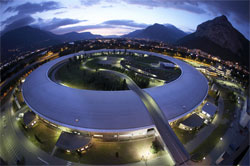Storage Ring Dust-Up
High-energy physicists have finally pinpointed their dust problem. Inside multi-million dollar storage rings, high-speed trains of electrons are often derailed by micron-sized specks of dust. Now a team has shown that dust grains arise from sparks inside a Japanese storage ring, as they report in an upcoming paper in Physical Review Special Topics–Accelerators and Beams (PRST-AB), a free, online journal. The team also serendipitously caught on video one of the tiny grains being swept along in the electron beam–the particle physics equivalent of a criminal caught by a security camera. The feat opens the possibility for further characterization of the dust.
A storage ring contains an evacuated pipe that channels high-energy particles in a large circle. In the case of electrons, the beam can generate electromagnetic radiation for experiments on material samples or it can slam into a target or a second beam to create high-energy collisions. For the past 30 years, storage rings across the world have suffered from sudden, unpredictable losses of electrons, which can cut short the lifetime of the beam. Such costly interruptions of experiments can occur from a few times per month to several times per day, depending on the facility.
Early on, physicists put the blame on dust particles, in part because these events only occur for rings filled with negatively charged particles. The idea is that a dust grain passing too close to the particle beam is stripped of electrons by collisions or by the strong electric field, leaving it with a high positive charge. If the beam consists of positrons or protons, the grain is repelled. But for an electron (or anti-proton) beam, the positively-charged dust particle is drawn into the center of the flow, where it’s trapped. Indirect evidence has come from the detection of stray gamma rays, from either bremsstrahlung radiation produced by an electron smacking into a dust grain, or from “duststrahlung” radiation caused by an electron scattering off of a dust grain’s strong electric field.
Although the “dust trapping” picture is well-accepted, “neither the source of dust nor the trapped-dust behavior has been fully elucidated yet,” says Yasunori Tanimoto of the High Energy Accelerator Research Organization (KEK) in Tsukuba, Japan. He and his colleagues tested one popular hypothesis, that electric discharges–sparks from the vacuum pumps or from the strong electric fields in the beams–are the culprits. Sparks could cause small pieces of metal or other materials to splinter off from any equipment in contact with the vacuum. The team placed movable electrodes in one section of the Photon Factory Advanced Ring at KEK and installed two video cameras and two gamma ray detectors. In several instances, the discharge created by the electrodes was followed by a burst of gamma rays, a reduction in vacuum quality, and a loss of electrons–all signs that dust had been created.
In one trial, the discharge-tracking video cameras failed to register a spark, but surprisingly, they spotted a dust grain streaking through the field-of-view like a shooting star. The “luminous body” appeared 9 times in 6 seconds, too frequently for a single grain circumnavigating the 377-meter ring. The team speculates that either a single grain oscillated back and forth in front of the cameras, or multiple grains were created in the event. The brightness of the grain suggested it was burning up at 1000 degrees Kelvin or more.
“The experiment shows that discharges are important in most cases, but there are other ways to make dust,” says Frank Zimmermann of CERN in Geneva, who is also the editor of PRST-AB. But more importantly, this research shows that images and presumably spectra of the trapped dust are possible, which could lead to a better understanding of the mysterious process by which the dust eventually burns up, says Zimmermann. There has been a lot of uncertainty over these details because the small dust volume combines high temperature with high charge density. “The trapped dust might possibly be a new form of matter,” Zimmermann says.
–Michael Schirber
Michael Schirber is a Corresponding Editor for Physics Magazine based in Lyon, France.
More Information
Lightsources.org: information on synchrotron radiation facilities, which use electron storage rings
Example of a theoretical model for dust in storage rings: F. Zimmermann, J. Seeman, and M. Zolotorev, SLAC-PUB-6788, June 1995 (92 KB pdf file)





